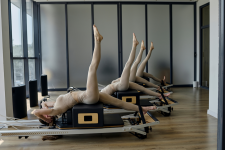
Hybrid Pilates Classes: Good or Bad?
That’s exactly what many Pilates-style studios are doing today: taking the classic modality and adding a strength-training twist (or several). That can often mean substituting airy, sun-filled studios for moody rooms and lighting, swapping spa-like tunes for Top 40 hits, and exchanging cues for stretching and light resistance for high rep counts and dumbbell exercises.
So, is a more traditional Pilates class the way to go (classics are classics for a reason), or are these new hybrid Pilates-cardio-strength workouts the most efficient, and perhaps even more fun, way to get in a good sweat?
The truth is, “it gets very confusing, very quickly,” says Joy Puleo, director of education at Balanced Body, as well as an instructor and teacher trainer. An increased interest in Pilates (it’s been earmarked as one of the biggest wellness trends of 2024), has brought with it the surge of new or expanding studios that offer “this sort of mix of using the reformer and trying to still maintain some of the value of the methodology that is Pilates,” says Puleo.
Here, experts share why there’s merit to both methods, and how to get the most out of your Pilates training no matter what vibe you’re after.
Principles of traditional Pilates
Joseph Pilates created and introduced the method in the 1920s as a rehabilitation and corrective movement practice alongside variations of an apparatus that would become what we know today as the reformer. The core principles, according to Puleo, include:
- Quality of movement
- Control
- Precision
- Whole-body coordination
- Focus on breath
“It’s an internal experience,” she says. ”It’s slow and controlled. The whole experience is intended to have a mind-body focus to it.”
You’ll notice that many of these core values are retained in more contemporary classes. For example, you’ll recognize an emphasis on the core, or the center powerhouse of the body, as well as precision and control in any Solidcore class, according to Taylor Bogenschuetz, director of training and development for the brand, which has locations across the country. What’s more, “both Pilates and [Solidcore] place a strong emphasis on the connection between the body and the mind,” adds Bogenschuetz.
How modern hybrid Pilates classes are different
While every hybrid Pilates studio and class format will vary, there are a few common elements.
They tend to be faster paced
“The biggest difference between a classical Pilates format and [our] style is the pace,” says Sheryll Estrellas, studio manager and instructor at VAURA, a new “athletic-style” reformer studio in New York City inspired by Australia’s club-like Vive Active. “We tend to move at a much faster pace in an effort to get the heart rate up and have that added cardio component to our classes.”
There’s usually weights involved
Solidcore “features alternate exercises, intensity, and pacing that offer the benefits found more so within traditional weight training,” says Bogenschuetz. And weight training is one of the major factors separating these hybrid classes from the classics: Both studios offer workouts that incorporate dumbbells ranging from 3 to 8 or 10 pounds.
Dumbbells “maximize time under tension,” or uninterrupted muscle engagement, as well as offer a way to “amplify” a movement with added load rather than relying solely on resistance from the reformer’s springs, explains Bogenschuetz.
“The additional load from the dumbbells is incorporated to increase the challenge to multiple muscle groups, strengthen joints, and enhance bone density,” says Estrellas of VAURA classes.
As a hybrid format, there’s a lot going on
It’s this two-for-one mentally, combining low-impact, core-focused Pilates with the high-energy, load-bearing exercises, that proponents say is the secret sauce of these hybrid classes.
Conversely, lovers of more traditional-style Pilates—whether on the mat or reformer—may be wondering if these combination classes offer efficiency or take away from the mindfulness origins of the practice.
So, should you combine Pilates with strength training and cardio or keep it separate?
The short answer is it depends—on your goals, preference, mood, and other workouts, says Puleo. If you enjoy loud music and a larger crowd to get hyped up, these high-energy classes might be the motivation you need. If you prefer a calmer, quieter environment that helps you stay present in your workout and attune to your body, a more traditional, smaller class setting may be perfect.
Either way, “it’s not the external experience,” says Puleo. “It’s really much more the internal, and a lot of it comes down to how the instructor creates the space.”
This mind-body connection and internal awareness is part of what Puleo says keeps Pilates clients hooked for life.
“The essence of Pilates is about building movement skills, and longevity of movement over time [to] help you do everything better,” she says. “[It’s] a movement practice and awareness practice as opposed to just an exercise routine. So, my fear is when we have classes that just answer the need to ‘feel the burn,’ if that’s all we’re doing, will clients just pass through?”
You also want to be mindful of overtraining. Balance your full-body, high-intensity, load-bearing classes with adequate rest or consider swapping some of these hybrid classes with a more restorative, yet still challenging, traditional Pilates reformer class, says Puleo.
If you’re totally new to Pilates but love to strength train—or vice versa—the same balanced approach should be applied. For example, if you’re already lifting weights three times a week, consider swapping one of those for a Pilates session, says Puleo.
“A good weekly strength training [workout] should be present somewhere [in your routine]. Especially as you age, some level of strength training is invaluable,” she says. “Should it be in one class? I don’t think it has to be one in class. Once you have a little more clarity on the differentiation of what Pilates brings and strength training brings, it’s much easier to come to an understanding of their integration.”
If you’re still not sure what kind of Pilates class is right for you, just go for what you enjoy. Move your body in whatever way feels right for you and make rest a priority, and you’ll be on the right track.





